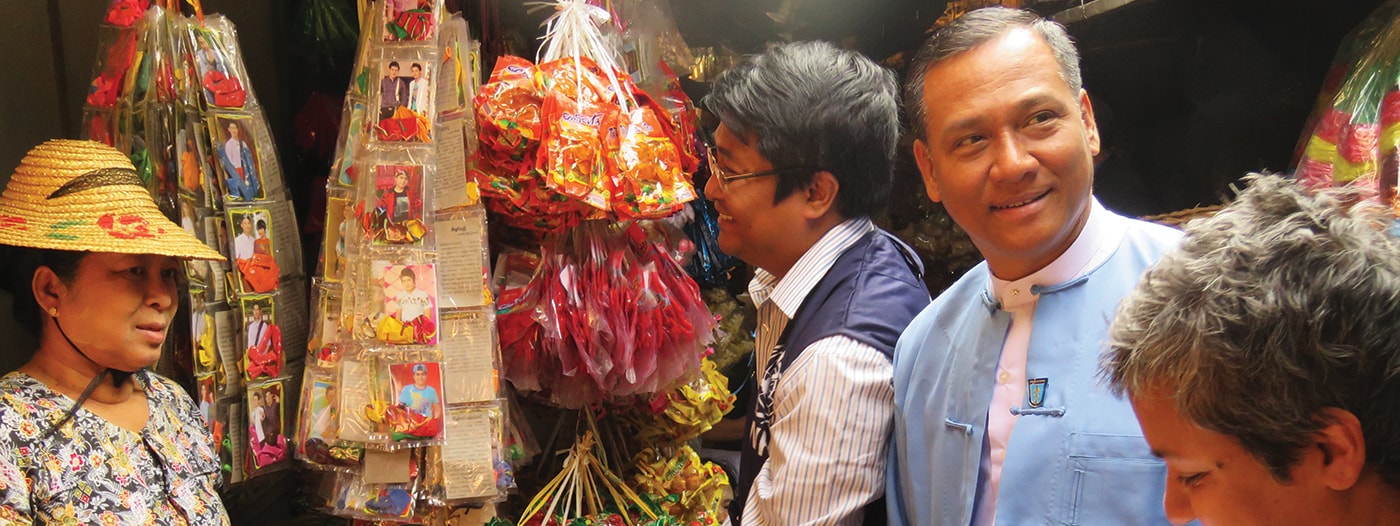CDC in Burma

Polio campaign in Burma, 2016. Photo by Deblina Datta, CDC
The Centers for Disease Control and Prevention (CDC) established a country office in Burma in 2015. CDC Burma supports the national HIV and TB programs through the U.S. President’s Emergency Plan for AIDS Relief (PEPFAR), builds capacity for surveillance and laboratory systems, and develops innovative strategies to sustain country-owned responses to HIV, TB, malaria, vaccine-preventable diseases, and most recently COVID-19.
CDC Impact in Burma
COVID-19
CDC’s close cooperation and support to respond to HIV, TB, and malaria, especially through capacity-building in laboratory and surveillance systems, has built a strong foundation for Burma’s efforts to prevent, detect, and respond to COVID-19. CDC’s technical staff worked with Ministry of Health (MOH) counterparts in 2020, and more recently through World Health Organization (WHO), UNICEF and other partners to respond to COVID-19. These efforts include: surveillance, laboratory technical assistance, and clinical education support; clinical tele-mentoring for healthcare workers and public health responders; and a hotline for information dissemination to the public.
Building on strengthened laboratory capacity to optimize the HIV testing algorithm, in 2020 CDC helped Burma develop COVID-19 testing algorithms for screening, diagnosis and contact-tracing.
HIV and Tuberculosis
As a key implementer of PEPFAR, CDC has been working through multilateral, nongovernmental and governmental partners to build a sustainable, effective and country-owned HIV response that accelerates progress toward UNAIDS targets to control the HIV epidemic.
CDC supports the National AIDS Program, the National Health Laboratory, and UNAIDS and WHO country offices, to develop innovative strategies and operationalize guidelines for HIV/AIDS prevention and treatment, and to strengthen systems for monitoring and improving the quality of HIV clinical care, surveillance, and laboratory services.
In 2020, supported Burma’s revision of the National Strategic Plan for HIV 2021-25, and secured the Global Fund grant for 2021-23 HIV response work.
Provided training on community-based HIV screening to accelerate HIV case-finding.
Pioneered telehealth approaches for HIV treatment continuity during the COVID-19 pandemic.
With tuberculosis (TB) as the leading cause of death among people living with HIV, CDC supports a health-systems strengthening approach to also tackle the challenge of drug-resistant TB. CDC supported the implementation of the 2019 national tuberculosis prevalence survey, and established quality assurance capacity for the national TB diagnostic network.
Malaria
In 2020, CDC added a malaria advisor to the interagency President’s Malaria Initiative (PMI) team in Yangon to focus on building national capacity for surveillance and outbreak investigation. This enables Burma’s continued work toward malaria elimination and containing the spread of artemisinin-resistant malaria.
Field Epidemiology Training Program
CDC has strengthened Burma’s ability to investigate and respond to communicable disease outbreaks like COVID-19 through the establishment of a Field Epidemiology Training Program (FETP). Burma’s FETP program is the cornerstone of a planned national public health institute. Globally, these epidemiologists or “disease detectives” are trained to identify and contain outbreaks before they grow. Training focuses on “learning by doing” to develop the skills for gathering critical data and turning it into evidence-based action.
Immunizations
In 2021, CDC added an immunizations advisor to the office in Yangon. CDC plans continued capacity-building support in immunizations surveillance, starting with the planning and monitoring of the national COVID-19 vaccination campaign, and recovering the immunization services that were significantly affected by the COVID-19 pandemic.
- 3 U.S. Assignees
- 3 Locally Employed
- Population: 54,409,794
- Per capita income: $4,860
- Life expectancy at birth: F 70/M 64 years
- Infant mortality rate: 37/1,000 live births
Sources: World Bank 2020; Population Reference Bureau 2020